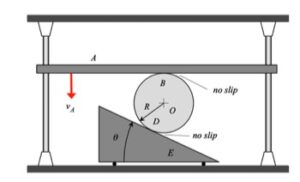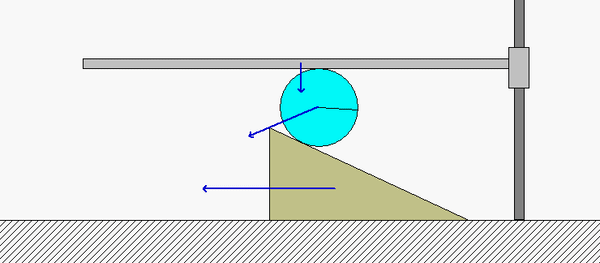| Problem statement Solution video |
DISCUSSION THREAD

Discussion
Consider the motion of the system shown below,

along with a freeze-frame of this motion that follows:

Points B and D on the disk roll without slipping on the horizontal guide A and the wedge E, respectively. Because of this:
- B has a velocity vB which points straight down, with the same speed vA as the horizontal guide A.
- D has a velocity vD which points directly to the left with the same speed as the wedge E.
The instant center (IC) of the disk (call it point C) therefore exists at the intersection of the perpendiculars to vB and vD. Note that point B is much closer to the IC than point D. What does this say about the relative sizes of vD and vB? Is this consistent with the speeds of D and B shown in the above animation?
HINTS:
- Use the above discussion points to locate the IC for the disk.
- Determine the angular speed of the disk based on the speed of B and the distance from B to C.
- The speed of the wedge E is found by using the angular speed from above and the distance from C to D.
Any questions?? Please ask/answer questions regarding this homework problem through the "Leave a Comment" link above.
If B and D are points of contact, shouldn't the velocity be zero? In the hint, it says that they are not zero as vB is downward and vD is left.
Since B is in no-slip contact with A where A is moving downward, B must be moving downward (with no horizontal component of velocity).
Since D is in no-slip contact with wedge E where E is able to move horizontally, D must be moving horizontally (with no vertical component of velocity).
Are we to assume that velocity at point O of the disk is zero?
No. If point O has zero velocity, the disk cannot move.
How are we supposed to find the distance between IC and B, and IC and D? Do we have to use geometry?
You can find those distances with some basic trig.
When approaching a problem like this one, something that I highly recommend is that you make sure that your drawing is clear. This will help you a lot to find the location of IC since the method requires to draw straight lines until the lines intersect. When doing so the trig will become easier to find as a result.
Part (a) asks us to determine the location of the instant center for the disk. Do they want this as a vector? And if so, with respect to what, since location is relative?
Simply showing its location in a figure will suffice.
How do we find the radius of B to D? Since D is not directly underneath B, how do we use the radius and the angle of the wedge to determine the distance between D and the IC and B and the IC?
For part a, how should we describe the location of the instant center? Would a vector from point B be sufficient?
Nevermind, the page refreshed and this question has been answered
I am a bit confused on where point D is actually supposed to be? It is unclear where that point is to be able to solve for radius in the velocity equations.
Point D is the point on the disk that is in contact with the wedge. Since D does not slip on the wedge, the velocity of D is the same as the velocity of the wedge, as the wedge moves to the left.
Point B is the point on the disk that is in contact with the horizontal bar A. Since B does not slip on bar A, the velocity of B is the same as the velocity of the bar, as the bar moves downward.
For the sake of practice, ensure that when finding the angular velocity, you pay attention to the sign. You'll be taking magnitudes, so the sign will depend on the rotation of the disk, use right hand rule.
It is given that the location of Ic is going to be where the tangent velocities of both point D and point B meet therefore, I would recommend drawing the point on a free body diagram to see if it actually where the tangent velocities meet or else there is a mistake in your calculations.
Geometrically, the horizontal distance between D and O is the same as the horizontal distance between the instant center and B.
To help find the distance between IC and B, IC and D you have to perform some basic trig. Look at how the wedge tringle can be transformed in order to find the distances between these points. Keeping in mind how the angle will be applicable. Hope this helps.
Is v_c equal to 0 in this situation? I am not sure how to go about solving if this is not the case.
From the lecture book: "Since C is the center of rotation, V_c = 0. Therefore, the velocity of any point on the body is perpendicular to the line connecting C to that point."
WILL: To which point C are you referring when you write v_C? If C is an instant center, then yes, by definition.
For the trig to find the distance between IC and B vector, I thought back to physics 172 where it was a block on a wedge where you would draw a normal vector and do the trig calculations to find the angles of the triangle with simple geometry. Very similar setup for finding angle and you can look up pics online if you are stuck.
Notably the distance from the distance from the instant center can by found by summing the radius and the j component of the radial vector pointing to point D from O.